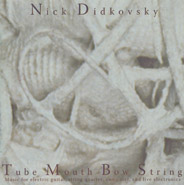Nick Didkovsky
Tube Mouth Bow String
(Pogus)
Nick
Didkovsky is mostly known for being the guitar player, composer and leader
of US group Doctor Nerve. Keeping in mind that all experiences that venture
beyond the well-worn path are nowadays by necessity a niche phenomenon,
I've often felt that the line-up's rock sound - where fanfare and metal
brilliantly coexist - has made for an undervaluation of Didkovsky's always
interesting, often quite original, compositional features. It goes without
saying that it's precisely those instrumental colours that make those compositions
so
"commercial" (!).
A
good example of "hidden complexity" outside Doctor Nerve is the
album Uses Wrist Grab, released a few years ago by the "virtual" trio
Bone. In the course of an interview we did not too long after the album
release, Didkovsky talked about some of the peculiarities of that work;
he also anticipated some things happening in the new experiences he was
involved in. After the interview was done, I was curious about the new
developments and their results, being at the same time impatient to hear
the new music and well aware that the gap that separates a new idea from
its realization is, financially speaking, very wide.
I'll
immediately say that Tube Mouth Bow String is a mature and interesting
work, brilliantly recorded, not at all "difficult" to enjoy.
It only needs one's (undivided) attention, silence (a lot), being open-minded
(it's obvious), love for beauty (this should go without saying, but...),
and lotsa curiosity. It appears this album has all the right ingredients
to become a best-seller!
A
good example of Didkovsky writing for a guitar quartet is Black Iris, the
long track featured on his solo album Binky Boy (1997), where the guitars
are played by Fred Frith, Mark Howell, René Lussier and Didkovsky himself.
Let's not forget those pages performed by the Fred Frith Guitar Quartet,
of which Didkovsky was a member; one track that comes to mind is She Closes
Her Sister With Heavy Bones: featured on Ayaya Moses (1997), it's the track
that - with a different arrangement and instrumentation - opens Tube Mouth
Bow String.
Though
the way they come to our ears may vary widely - sometimes inscrutable,
sometimes deceptively simple - Didkovsky's compositional coordinates always
create complex interactions between writing and performing; we have to
keep in mind the mathematical complexities of software's underlying logic,
and the research on acoustics. Tube Mouth Bow String offers five different
examples of combinations of elements. Let's not forget about the CD booklet:
rich with liner notes that are quite useful for understanding the tracks,
it also gives some Web addresses which can help listeners enrich their
experience of this music.
For
electric guitar and string quartet, She Closes Her Sister With Heavy Bones
opens with a fluid melody played by the guitar which is then reiterated
while the guitar gets progressively engulfed by the string instruments
of the Sirius String Quartet. The whole stays fresh and accessible for
the whole of its duration (6'41" which seem to fly away), the resulting
musical picture being extremely well-done and quite involving. In the end,
the guitar melody is present only "by implication".
For
electric guitar and computer, the brief (4'17") - and quite
"rocking" - Machinecore features Didkovsky's guitar through the
permutations operated by a complex program, with fascinating results.
For
string quartet and real-time modifications, the long (12'27") composition
that gives the CD its title is in my opinion its peak moment. I'm sure
the listener will be able to trace antecedents and similarities for it,
but the whole is in my opinion something quite original - something possessing
a mysterious and sinister beauty. A composition that's quite difficult
to be performed accurately (what we have here being the fruit of an overdubbing
process), Tube Mouth Bow String has strings, pedals and talk boxes (a good
example of the utilization of the talk box being the guitar solo in Haitian
Divorce by Steely Dan, on The Royal Scam). A very complex development,
and a sonic landscape that listeners will enjoy exploring.
I
found the following composition, What Sheep Heard, for string quartet and
computer, to be not as convincing as the CD title track (but what could
be?). I'm sure I'd find its precise modifications to be quite fascinating
in a concert hall (it's 21'07" long), and I was every time I managed
to (mentally) turn the room where my hi-fi system is located into a concert
hall - it just didn't happen every time I listened to it. (By the way,
the CD really needs space to properly reverberate, so to get the proper "3D"
dimension. There are also very complex relationships between the two stereo
channels.)
Closing
the CD, the brief (2'49"), and deceptively simple, Just A Voice That
Bothered Him, for string quartet.
Beppe Colli
© Beppe Colli 2007
CloudsandClocks.net | Mar. 12, 2007











